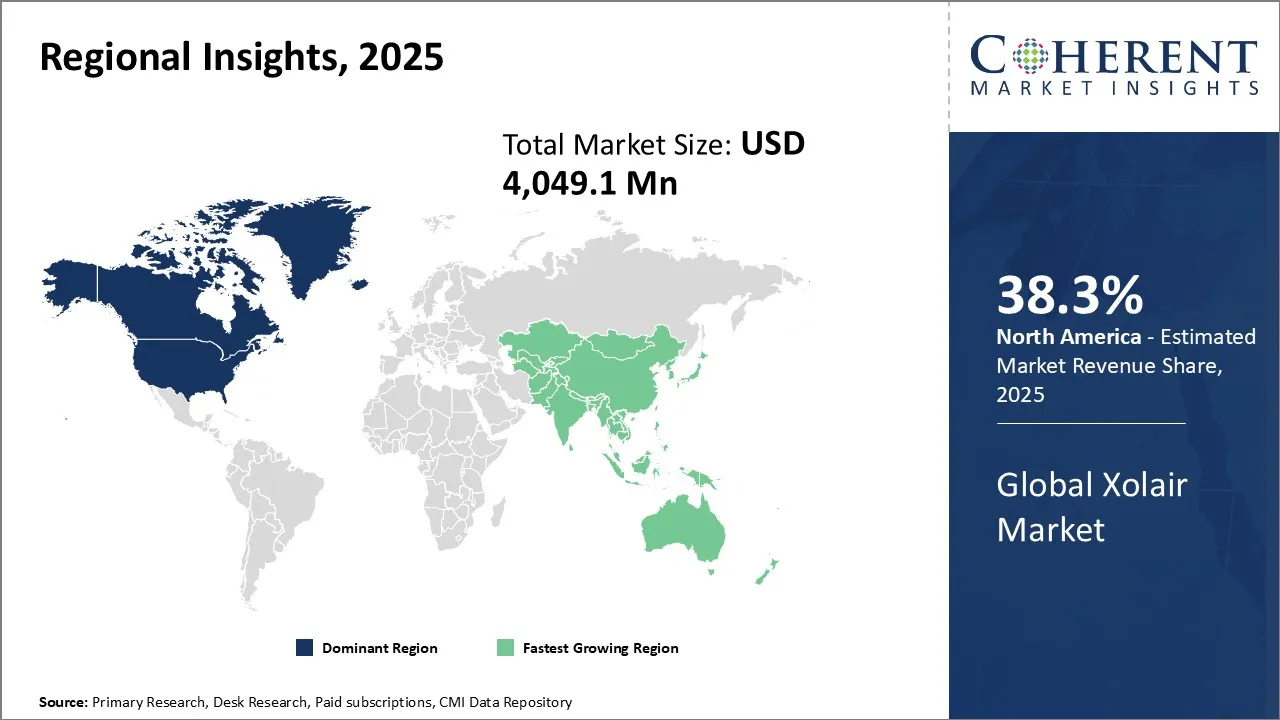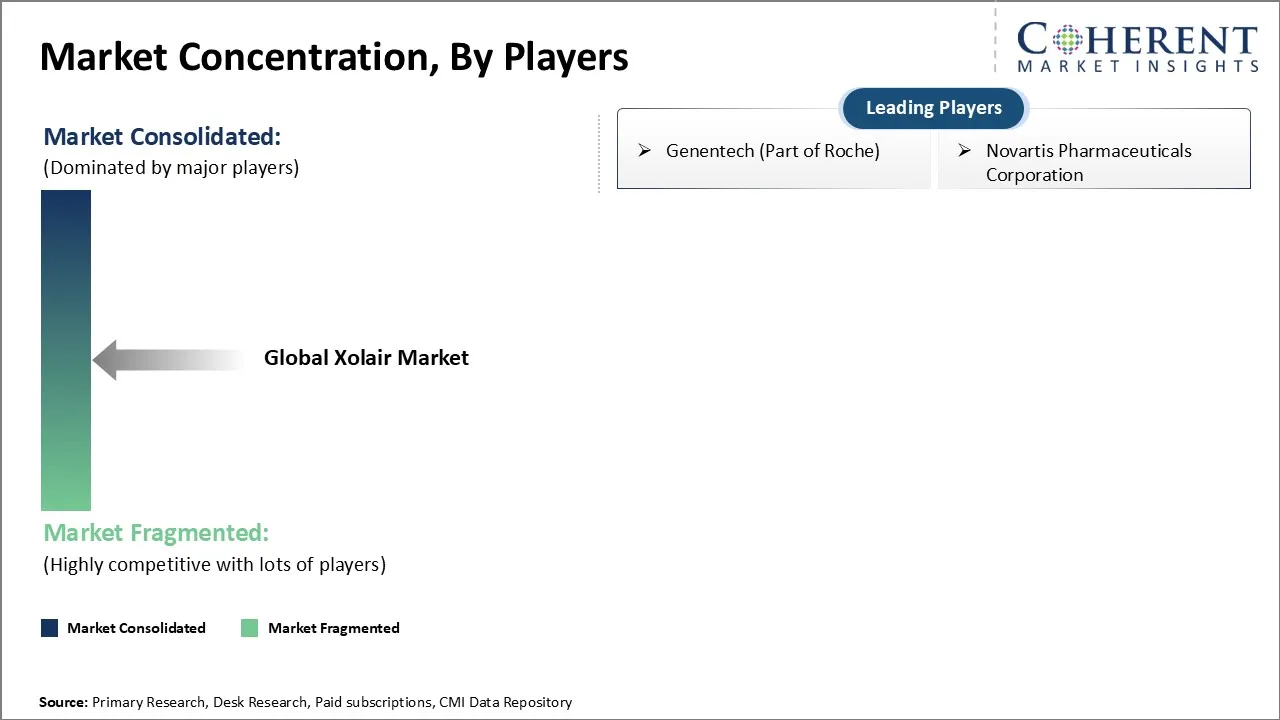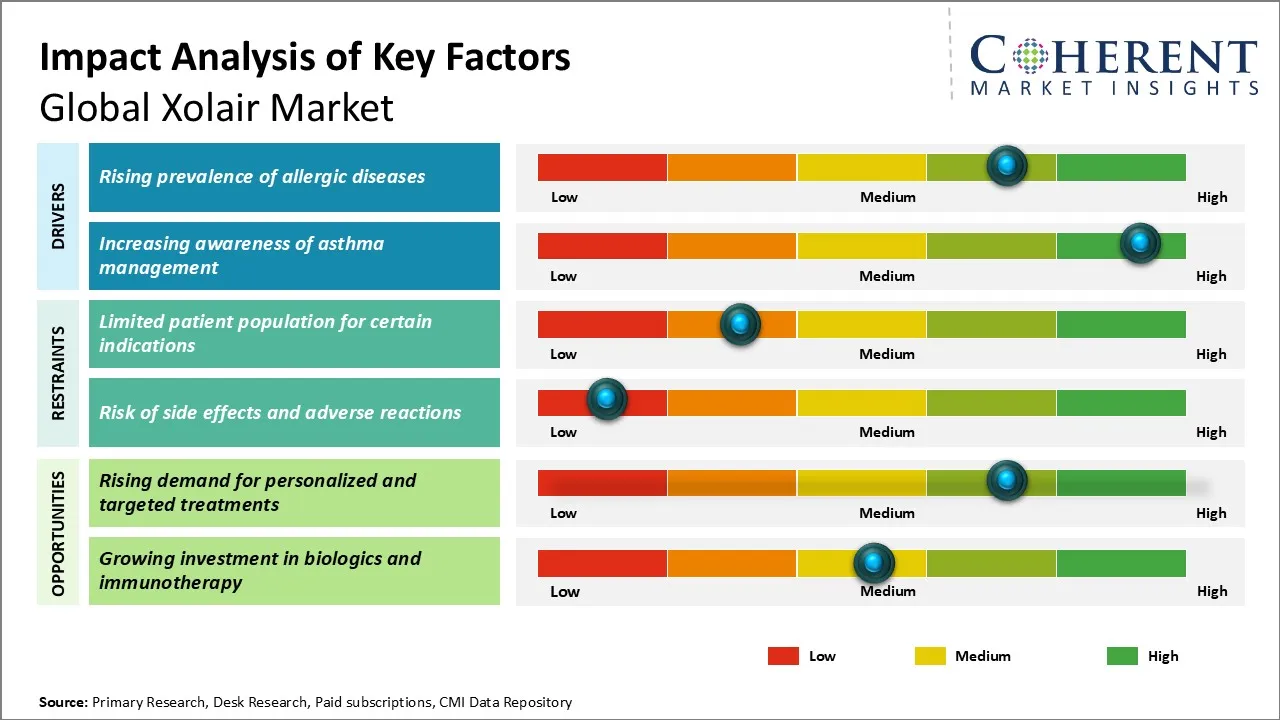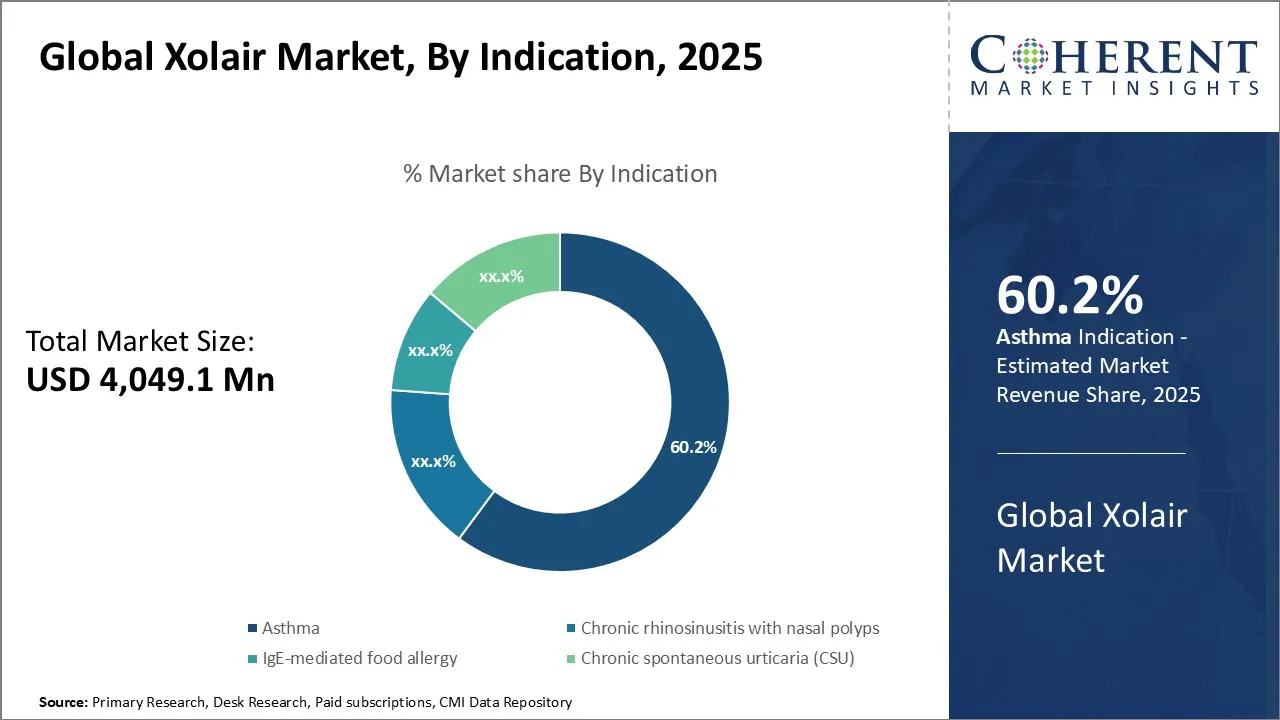Global Xolair Market Size and Forecast – 2025 to 2032
The Global Xolair Market is estimated to be valued at USD 4,049.1 Mn in 2025 and is expected to reach USD 2,269.4 Mn by 2032, declining at a compound annual growth rate (CAGR) of -7.9% from 2025 to 2032. This negative growth rate indicates a significant contraction in the market size over the forecast period, suggesting potential challenges and shifts in the demand for Xolair.
Key Takeaways of the Global Xolair Market
- In 2025, asthma segment is expected to hold the largest share of the Xolair market, accounting for 60. 2%, driven by several key factors.
- In terms of strength, the 75 mg/0.5 mL formulation of Xolair is projected to contribute the highest market share at 35. 2% in 2025.
- The single-dose prefilled syringe is expected to dominate the market with a 34. 4% share due to its convenience, ease of use, reduced risk of contamination, and improved patient compliance.
- North America is expected to lead the market, holding a share of 38. 3% in 2025.
- Asia Pacific is anticipated to be the fastest-growing region, with a market share of 28. 2% in 2025.
Market Overview
The market trend for Xolair is characterized by a declining trajectory, possibly influenced by factors such as increased competition from alternative treatments, changes in healthcare policies, or evolving patient preferences. The negative CAGR highlights the need for stakeholders to closely monitor market dynamics, assess the underlying causes of the decline, and develop strategies to mitigate the impact on their businesses. Adapting to the changing market landscape, exploring new target markets, and investing in research and development to improve product efficacy and differentiation may be crucial for companies operating in the Xolair market to navigate through this challenging period.
Current Events and Its Impact
|
Current Events |
Description and its impact |
|
Advancements in Alternative Therapies and Treatment Modalities
|
|
|
Rising Competition from Biosimilars |
|
Uncover macros and micros vetted on 75+ parameters: Get instant access to report
Xolair Market Insights, By Indication - Asthma Segment: Dominant due to increasing prevalence and Xolair's efficacy in severe allergic asthma
In terms of indication, the asthma segment is estimated to contribute the highest share of the market with 60.2% in 2025. The increasing prevalence of severe persistent allergic asthma worldwide has created a significant demand for effective treatment options like Xolair. Patients with this form of asthma often struggle to control their symptoms despite the use of high-dose inhaled corticosteroids and long-acting beta-agonists, leading to a heightened need for targeted therapies.
Xolair's unique mechanism of action, which involves binding to and neutralizing IgE antibodies, has proven to be highly effective in managing severe allergic asthma. Clinical studies have shown that Xolair significantly reduces the frequency of asthma exacerbations, improves lung function, and enhances patients' overall quality of life. This compelling evidence has driven its widespread adoption by healthcare providers and patients alike.
For Example, June 2024 article from International Immunopharmacology discusses the role of precision medicine in managing severe asthma, emphasizing the use of biomarkers and monoclonal antibodies like Xolair for personalized treatment. Severe asthma is a complex and heterogeneous condition, and biological agents targeting IgE, IL-4, IL-5, and TSLP have proven effective in reducing exacerbations, improving lung function, and enhancing quality of life. These advancements, including Xolair, have significantly transformed asthma management, although continued research into the disease's pathogenesis and new therapies is essential for further progress.
Xolair Market Insights, By Strength - 75 mg/0.5 mL Strength: Dominant due to its flexibility in dosing, allowing tailored treatment
In terms of strength, the 75 mg/0.5 mL formulation segment of Xolair is expected to contribute the highest share of the market with 35.2% in 2025. This can be attributed to several factors that have made this strength a preferred choice among healthcare providers and patients.
One of the primary reasons for the dominance of the 75 mg/0.5 mL strength is its versatility in dosing. This formulation allows for flexible dosing regimens based on a patient's body weight and baseline IgE levels, enabling individualized treatment plans. The ability to adjust the dose according to specific patient requirements has made this strength highly favored by physicians.
Xolair Market Insights, By Packaging- Single-dose Prefilled Syringe: Dominant due to its convenience, ease of use, and reduced dosing errors
Based on packaging, the single-dose prefilled syringe segment is expected to contribute the highest share of the market with 34.4% in 2025 for Xolair .This packaging option has gained popularity due to several advantageous factors that have driven its widespread adoption.
Firstly, the single-dose prefilled syringe offers unparalleled convenience and ease of use for both patients and healthcare providers. The medication comes pre-filled in the syringe, eliminating the need for manual preparation or reconstitution. This simplifies the administration process, reduces the risk of dosing errors, and saves valuable time for healthcare professionals.
Pricing Analysis of Xolair
- The price of Xolair (150 mg subcutaneous powder for injection) shows significant variation across different countries, with the United States having the highest price at approximately USD 1,521.73. In contrast, the lowest price is seen in Australia, where it costs USD 140.149. European countries, such as the Netherlands, Ireland, and Germany, report mid-range prices, with the Netherlands at USD 339.765 and Germany at USD 718.159. Countries in the Middle East, like the U.A.E and Saudi Arabia, exhibit prices around USD 620 and USD 478, respectively. Developing markets such as India and Mexico feature more affordable pricing, with India at USD 418.571 and Mexico at USD 620.112. This pricing disparity can be attributed to factors such as local healthcare infrastructure, government subsidies, and market competition.
- Looking ahead, the price of Xolair is expected to increase significantly in many countries by 2032. The U.S. is projected to see the largest price increase, with an estimated rise of 35-40%. Other countries like Canada, Germany, and the U.K. anticipate a 20-30% increase in Xolair's price. In emerging markets such as India and Mexico, the price is forecasted to increase by 25%, reflecting both inflation and the growing adoption of biologic These anticipated changes in pricing may impact patient access and affordability, particularly in low-income regions, where cost barriers could limit treatment accessibility.
Regional Insights

To learn more about this report, Download Free Sample
North America Xolair Market Analysis and Trends
North America is projected to dominate the global Xolair market with a share of 38.3% in 2025. The region boasts a well-established healthcare infrastructure, with advanced medical facilities and a strong emphasis on research and development. The presence of key market players, such as Novartis and Genentech, further solidifies North America's position as a leader in the Xolair market. These companies have made significant investments in the development and commercialization of Xolair, leveraging their extensive distribution networks and partnerships with healthcare providers. Additionally, favorable government policies and reimbursement scenarios have contributed to the widespread adoption of Xolair in the region.
In May 2024, according to World Health Organization (WHO) study, asthma is a chronic lung disease affecting 262 million people globally, causing symptoms like coughing, wheezing, and shortness of breath. It leads to 455,000 deaths annually, with the highest mortality in low- and middle-income countries due to under-diagnosis and inadequate treatment. Although asthma can be managed with medication and by avoiding triggers, severe cases may require emergency care. The WHO is focused on improving diagnosis, treatment, and monitoring to reduce asthma’s global impact.
Asia Pacific Xolair Market Analysis and Trends
Meanwhile, the Asia Pacific region is expected to exhibit the fastest growth in the global Xolair market with a share of 28.2% in 2025. Countries such as China, Japan, and Australia have witnessed significant market growth due to their large patient populations and improving healthcare infrastructure. Moreover, the expanding middle class and increasing disposable incomes in the region have made advanced treatments like Xolair more accessible to a wider population. Governments in the Asia Pacific region have also implemented policies and initiatives to improve healthcare access and encourage the adoption of innovative therapies. The entry of key market players like Roche and collaborations with local companies have further fueled the growth of the Xolair market in the region.
Global Xolair Market Outlook for Key Countries
U.S. Xolair Market Trends
The U.S. market for Xolair, while once highly developed and mature, is now experiencing slow growth and a negative compound annual growth rate (CAGR). The prevalence of asthma and chronic idiopathic urticaria (CIU) remains high, driving demand for effective treatments like Xolair. However, the market is facing challenges such as increasing competition from alternative therapies and biosimilars, as well as growing cost pressures within the healthcare system. While Novartis and Genentech continue to play significant roles with extensive distribution networks and partnerships, the overall market potential for Xolair is being constrained by these factors, leading to slower adoption and reduced growth prospects.
According to the Asthma and Allergy Foundation of America 2024, over 28 million people in the U.S. have asthma, with higher rates among low-income, senior, and minority groups. It is more common in women and male children. While there's no cure, asthma can be managed with proper treatment to prevent attacks and improve quality of life, making it one of the most common and costly diseases in the U.S.
China Xolair Market Trends
In China, the Xolair market has been rapidly growing due to a large patient population, rising healthcare expenditure, and increasing awareness of the drug’s benefits. However, despite these factors, the market is starting to show signs of slower expansion, driven by the increasing availability of cheaper alternatives and government efforts to regulate drug pricing. Local companies' collaborations with international market players have expanded the availability of Xolair, but competition from both local and global biosimilars is likely to slow down the pace of market growth in the coming years.
In January 2025, a 16-week real-world study evaluated the safety and effectiveness of Xolair in Chinese adolescents with Chronic Spontaneous Urticaria inadequately controlled by H1 antihistamines. The study will assess safety, effectiveness and quality of life through routine care visits, with no extra procedures beyond standard clinical assessments.
Japan Xolair Market Trends
Japan remains a key market for Xolair, with its aging population and high prevalence of asthma and CIU. Despite a strong healthcare system and increasing demand, the market for Xolair in Japan is also facing challenges due to the growing adoption of more affordable alternatives and biosimilars. Novartis has maintained a strong presence in Japan, but like other markets, the Xolair market in Japan is now experiencing slower growth and a negative CAGR, primarily due to pricing pressures and the growing preference for cost-effective therapies.
For instance, in March 2023, according to the National Library of Medicine, a study in Japan analyzing data from 2020 found that chronic rhinosinusitis (CRS) significantly increases disease burden, with higher comorbidities, healthcare utilization, and medication prescriptions compared to those without CRS. Patients with CRS, especially those with eosinophilic CRS, were more likely to use systemic corticosteroids (SCS), despite SCS not being generally recommended for long-term use. The study highlighted the need for better treatment strategies to manage CRS and its associated conditions.
Germany Xolair Market Trends
Germany’s Xolair market, characterized by a robust healthcare system and strong research and development focus, continues to see demand for asthma and CIU treatments. However, the market growth has slowed significantly, with key players like Novartis facing challenges due to increasing competition and government policies focused on controlling healthcare costs. While favorable reimbursement policies initially supported Xolair’s adoption, the market now faces a more competitive landscape, resulting in a decrease in the market share and slow growth moving forward.
For Instance, in July 2022, a study in Germany found that despite treatment according to NVL/GINA step 4/5 guidelines, about 54,000 out of 625,000 severe asthma patients had poor control, with up to 15% showing signs of inadequacy in certain regions in 2019. The study highlighted that only 12,000 patients were receiving biological treatments, suggesting a potential treatment gap in managing uncontrolled asthma.
Market Players, Key Developments, and Competitive Intelligence

To learn more about this report, Download Free Sample
Key Developments
- In February 2024, Genentech, a member of the Roche Group, announced U.S. FDA approval of Xolair (omalizumab) as the first and only medication for reducing allergic reactions, including anaphylaxis, due to food allergies in patients aged 1 year and older. This approval is based on the National Institutes of Health (NIH)-sponsored Phase III OUtMATCH study, which showed that Xolair significantly increased the tolerance to foods like peanuts, milk, eggs, and cashews without causing allergic reactions, compared to a placebo.
- In March 2023, according to data published by the National Institutes of Health, Roche's Xolair (omalizumab) has been shown to treat multi-food allergies more effectively than oral immunotherapy (OIT), according to results from the OUtMATCH trial. In the study, 36% of participants treated with omalizumab could tolerate 2 grams or more of peanut protein and two other food allergens, compared to only 19% of those treated with OIT. The difference was largely due to the high rate of allergic reactions and intolerable side effects with OIT, which led 25% of participants to discontinue treatment. These findings were presented at the 2025 American Academy of Allergy, Asthma & Immunology Congress in the U.S.
- In April 2021, Novartis announced that the U.S. FDA had approved the Xolair (omalizumab) prefilled syringe for self-injection across all approved indications. This approval provides healthcare providers and patients with a more flexible treatment option for managing conditions like moderate to severe persistent allergic asthma, chronic idiopathic urticaria (CIU), and nasal polyps.
- In December 2020, Novartis Pharmaceuticals Corporation announced that the U.S. FDA had approved Xolair (omalizumab) for the add-on maintenance treatment of nasal polyps in adults aged 18 and older who have an inadequate response to nasal corticosteroids. This makes Xolair the first biologic to target and block immunoglobulin E (IgE), a key driver of inflammation in nasal polyps.
Market Report Scope
Xolair Market Report Coverage
| Report Coverage | Details | ||
|---|---|---|---|
| Base Year: | 2024 | Market Size in 2025: | USD 4,049.1 Mn |
| Historical Data for: | 2020 To 2024 | Forecast Period: | 2025 To 2032 |
| Forecast Period 2025 to 2032 CAGR: | -7.9% | 2032 Value Projection: | USD 2,269.4 Mn |
| Geographies covered: |
|
||
| Segments covered: |
|
||
| Companies covered: |
Genentech (Part of Roche) and Novartis Pharmaceuticals Corporation |
||
| Growth Drivers: |
|
||
| Restraints & Challenges: |
|
||
Uncover macros and micros vetted on 75+ parameters: Get instant access to report
Xolair Market Dynamics

To learn more about this report, Download Free Sample
Xolair Market Driver - Rising Prevalence of Allergic Diseases
The increasing prevalence of allergic diseases worldwide has historically been a significant driver for the Xolair market. Conditions like asthma, chronic idiopathic urticaria (CIU), and nasal polyps have been rising due to factors such as environmental changes, urbanization, and lifestyle shifts. However, despite the growing number of diagnoses, the market for Xolair is experiencing a decline with slow growth and a negative compound annual growth rate (CAGR). This decline is influenced by several factors, including the availability of alternative treatments, rising healthcare costs, and the emergence of biosimilars. Although Xolair, a monoclonal antibody, remains an effective option for severe allergic asthma and CIU in patients who do not respond well to conventional therapies, its market potential is constrained by increasing competition and price sensitivity, limiting the demand for this biologic treatment in the long term.
For instance, in August 2023, according to the Journal of American Academy of Allergy, Asthma & Immunology, allergies are increasingly prevalent in India, affecting 20-30% of the population, with conditions like asthma, rhinitis, and food allergies. Modern lifestyles, environmental factors, and diet contribute to this rise. Respiratory allergies worsen during the monsoon, and severe reactions like anaphylaxis can be life-threatening. Managing allergies involves avoiding triggers, using antihistamines drugs, and administering adrenaline for severe reactions. Early diagnosis, awareness, and education, especially for parents, are crucial to improving management and preventing life-threatening situations.
Xolair Market Opportunity - Rising Demand for Personalized and Targeted Treatments
The global Xolair market is poised to benefit from the rising demand for personalized and targeted treatments. As the healthcare industry shifts towards precision medicine, there is a growing emphasis on developing and delivering therapies that are tailored to individual patient needs and characteristics. Xolair, with its targeted mechanism of action against immunoglobulin E (IgE), aligns well with this trend. By selectively targeting IgE, Xolair offers a personalized approach to managing severe allergic asthma and CIU in patients who have specific biomarkers or clinical profiles. The increasing recognition of the importance of personalized medicine, coupled with advancements in biomarker identification and diagnostic tools, presents a significant opportunity for Xolair to expand its market presence. Furthermore, the rising prevalence of allergic diseases and the need for effective, long-term management options create a favorable environment for Xolair's growth.
For instance, in May 2023, according to the National Library of Medicine, an article explores the challenges and advancements in inhaled drug delivery for asthma treatment. It highlights the need for patient-specific therapies due to varying asthma subtypes and discusses innovations like monoclonal antibody delivery, mucolytic treatments, and gene therapies. The potential for inhaled vaccines to prevent asthma is also considered.
Analyst Opinion (Expert Opinion)
- The global Actemra market is experiencing a steady decline, primarily driven by the increasing availability of biosimilars and the growing preference for more cost-effective treatment options. While Actemra, a leading monoclonal antibody used for conditions like rheumatoid arthritis and cytokine release syndrome, has seen widespread adoption in the past, its market share is now under pressure from generic alternatives and regulatory shifts favoring lower-cost drugs. Despite its proven efficacy, the high cost of Actemra and its limited growth prospects in newer indications are contributing to its gradual market contraction. Additionally, the impact of the COVID-19 pandemic has further stressed healthcare budgets, reducing the willingness of health systems to adopt expensive treatments.
- Recent conferences, such as the American College of Rheumatology's annual meetings and the European League Against Rheumatism (EULAR) congress, have provided a platform for discussing new therapies and treatment paradigms in autoimmune diseases and cytokine release syndrome. These events have been crucial for fostering collaborations, presenting emerging research, and discussing the market’s evolving landscape. Governments and healthcare providers are also pushing for initiatives aimed at improving patient access to biologic therapies, including Actemra, through cost-reduction strategies, such as biosimilar approval pathways. However, with competition intensifying and pricing pressures mounting, the Actemra market outlook appears to be on a steady decline rather than a growth trajectory.
Market Segmentation
- Indication Insights (Revenue, USD Mn, 2020 - 2032)
- Asthma
- Chronic rhinosinusitis with nasal polyps
- IgE-mediated food allergy
- Chronic spontaneous urticaria (CSU)
- Strength Insights (Revenue, USD Mn, 2020 - 2032)
- 75 mg/0.5 mL
- 150 mg/mL
- 300 mg/2 mL
- 150 mg for lyophilized powder
- Packaging Insights (Revenue, USD Mn, 2020 - 2032)
- Single-dose prefilled syringe
- Prefilled Autoinjector
- Single-dose vial
- Patient Age Group Insights (Revenue, USD Mn, 2020 - 2032)
- Adult
- Pediatric
- Geriatric
- Sales Channel Insights (Revenue, USD Mn, 2020 - 2032)
- Online
- Offline
- End User Insights (Revenue, USD Mn, 2020 - 2032)
- Hospitals
- Outpatient Clinics
- Specialized Infusion Centers
- Others (Academics and Research Institutes, etc.)
- Regional Insights (Revenue, USD Mn, 2020 - 2032)
- North America
- U.S.
- Canada
- Latin America
- Brazil
- Argentina
- Mexico
- Rest of Latin America
- Europe
- Germany
- U.K.
- Spain
- France
- Italy
- Russia
- Rest of Europe
- Asia Pacific
- China
- India
- Japan
- Australia
- South Korea
- ASEAN
- Rest of Asia Pacific
- Middle East
- GCC Countries
- Israel
- Rest of Middle East
- Africa
- South Africa
- North Africa
- Central Africa
- North America
- Key Players Insights
- Genentech (Part of Roche)
- Novartis Pharmaceuticals Corporation
Sources
Primary Research Interviews
- Healthcare Providers (Pulmonologists, Allergists)
- Patients with Asthma or Chronic Spontaneous Urticaria
- Pharmacists
- Biopharmaceutical Experts
Databases
- World Health Organization (WHO)
- U.S. Food and Drug Administration (FDA)
- European Medicines Agency (EMA)
- Centers for Medicare & Medicaid Services (CMS)
- National Institutes of Health (NIH)
- Global Health Observatory (GHO) by WHO
Magazines
- Pharmaceutical Technology
- BioPharma Dive
- MedPage Today
- The Lancet Respiratory Medicine
- Drug Discovery Today
Journals
- The New England Journal of Medicine
- Journal of Clinical Investigation
- International Archives of Allergy and Immunology
- Annals of Allergy, Asthma & Immunology
- Journal of Immunology
Newspapers
- The New York Times
- The Wall Street Journal
- The Guardian
- The Financial Times
Associations
- American College of Allergy, Asthma & Immunology (ACAAI)
- European Respiratory Society (ERS)
- Global Initiative for Asthma (GINA)
- American Academy of Allergy, Asthma & Immunology (AAAAI)
- World Allergy Organization (WAO)
Public Domain Sources
- World Bank Health Data
- Centers for Disease Control and Prevention (CDC)
- National Health Service (NHS) Health Data
- Global Health Data Exchange (GHDx)
- UN Comtrade Database
Proprietary Elements
- CMI Data Analytics Tool: Proprietary analytics tool to analyze real-time market trends, consumer behavior, and technology adoption in the market
- Proprietary CMI Existing Repository of Information for the Last 8 Years
Share
Share
About Author
Vipul Patil is a dynamic management consultant with 6 years of dedicated experience in the pharmaceutical industry. Known for his analytical acumen and strategic insight, Vipul has successfully partnered with pharmaceutical companies to enhance operational efficiency, cross broader expansion, and navigate the complexities of distribution in markets with high revenue potential.
Missing comfort of reading report in your local language? Find your preferred language :
Transform your Strategy with Exclusive Trending Reports :
Frequently Asked Questions
EXISTING CLIENTELE
Joining thousands of companies around the world committed to making the Excellent Business Solutions.
View All Our Clients


